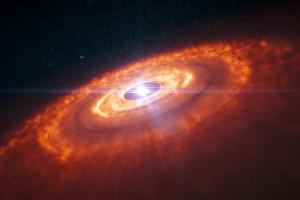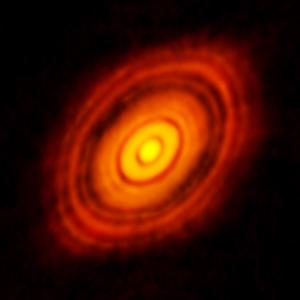Blog
A Gap in Our Understanding
12 September 2023
 ESO/L. Calçada
ESO/L. CalçadaRoughly 5 billion years ago Earth was in the process of forming. Gas and dust gathered with the young Sun’s protoplanetary disk, likely nudged a bit by the resonant gravitational pull of Jupiter and other large worlds. One can imagine that as Earth formed it swept its orbit clear of debris, leaving a gap in the disk visible from light years away. While we know this tale is reasonably accurate, the idea that planets such as Earth always clear gaps in a protoplanetary disk likely isn’t.
For decades, the idea of planets forming from the debris of young stars was supported by low-resolution images of disks around stars such as Fomault. The gas and dust surrounding young stars are often cold and faint, making it difficult to study. But advanced radio telescopes such as ALMA have now captured detailed images of these disks. Many of them possess ringed gaps largely clear of debris, and some of these gaps contain visible protoplanets. So a general consensus is that gaps in a disk indicate the presence of planets, even if we can’t observe them directly. But a new study finds things are much more complicated.1
 ALMA (ESO/NAOJ/NRAO)
ALMA (ESO/NAOJ/NRAO)The team looked at N-body simulations of early disks, in which 3 - 7 protoplanets interact with gas, dust, and pebbles within the disk. Their model is sophisticated enough to look not only at how these planets accrete matter and grow, but also how the orbits planets can migrate through gravitational interactions, and how interactions with the disk can change the shape of an orbit or its orientation relative to the disk. They simulated these systems over a span of 100 million years, which is long enough to study how the planets might settle into stable orbits.
One of the things they found was that within a young disk, 5 - 7 protoplanets quickly develop unstable orbits. In their simulations, stability dissolved within 40,000 years, which is the blink of a cosmic eye. It would take much longer than that for the planets to clear a gap in the disk. This means that where we see 5 or more gaps in a protoplanetary disk, they cannot all be cleared by planets. It’s possible that the rings are caused by the orbital resonances of a particularly large planet, similar to the way Jupiter worked to prevent planet formation within the asteroid belt.
Another discovery was that the planetary orbits can migrate and shift dramatically, which again wouldn’t allow them to clear their orbital path. Smaller worlds in particular likely spend their early days moving through the disk in chaotic ways. Our young Earth likely migrated significantly as it formed, spending most of its time hidden among gas and dust rather than visible in a gap. This means we often won’t see Earth-like worlds forming in a protoplanetary disk, since we can’t pick them out from the overall glow of the disk.
All of this means that we can’t make a simple connection between the number and size of gaps seen in early planetary disks and the number and distribution of exoplanets we see in evolved star systems. Planetary formation is a complex dance, and while we know some of the steps, there are still plenty for us to learn.
Tzouvanou, Anastasia, Bertram Bitsch, and Gabriele Pichierri. “Do all gaps in protoplanetary discs host planets?” Astronomy & Astrophysics 667 (2023): A82. ↩︎